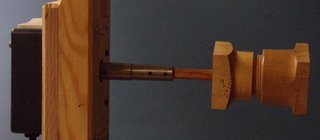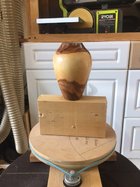I've got a can of brush-on lacquer that I'd like to use, but want a spray finish. Anyone ever dilute it with lacquer thinner and spray it with an airbrush? I'd be using a 0.5mm needle size. If you've done it, what was your dilution ratio, and did it give a good finish? Thanks.
-
April 2025 Turning Challenge: Turn an Egg! (click here for details) -
Congratulations to Kelly Shaw winner of the March 2025 Turning Challenge (click here for details) -
Congratulations to Ellen Starr for "Lotus Temple" being selected as Turning of the Week for 21 April, 2025 (click here for details) -
Welcome new registering member. Your username must be your real First and Last name (for example: John Doe). "Screen names" and "handles" are not allowed and your registration will be deleted if you don't use your real name. Also, do not use all caps nor all lower case.
You are using an out of date browser. It may not display this or other websites correctly.
You should upgrade or use an alternative browser.
You should upgrade or use an alternative browser.
Spraying Brush-On Lacquer
- Thread starter Ed Weingarden
- Start date
If you're finishing a something of low value, go for it - what the heck, nothing to lose.
If a gallery piece, urn or special gift, no way. Finishes are generally engineered to be used in accordance with their label.
I totally understand you wanting to spray - to my thinking, paint brushes are for the house applying stuff like pigmented latex to the outside or enamels to trim - clear and brush should never be in the same sentence.
Good luck - hope whatever it is comes out.
If a gallery piece, urn or special gift, no way. Finishes are generally engineered to be used in accordance with their label.
I totally understand you wanting to spray - to my thinking, paint brushes are for the house applying stuff like pigmented latex to the outside or enamels to trim - clear and brush should never be in the same sentence.
Good luck - hope whatever it is comes out.
Thanks for your insights John.
iv‘e sprayed it. It is basically the same stuff, except it is slower to dry to allow the brush marks flow out. If you cut it 50/50 with a cheap lacquer thinner it will speed up the drying time. If spayed full strength on a vertical surface it may run. Think of it as adding a retarder to lacquer.
Brushing lacquer is Likely to have a lot of thinner/retarder in it already to keep it from drying out to quick when applying so I would thin as little as possible. Other than that it will work but will likely take longer to “cure” due to the extra solvents.
I think the trick would be to spray only a light coat. Let it dry. Shouldn't take too long. Spray another coat. Continue. But let it dry between coats.
Maybe a small container with lacquer thinner to keep the airbrush wet between coats.
Maybe a small container with lacquer thinner to keep the airbrush wet between coats.
I have been spraying it for years without any problems. I have done it straight from the can but I usually do about a 1 to 8 reduction using a cheap HF gun. When spraying hollow forms, which for me always have threaded lids I use a rotator as shown, then I can spray a heavy coat and not worry about runs or orange peal. The threaded adapters have a 1/2" dowel to mount to the rotator and they can also be used on the lathe with the scroll chuck where the dowel fits without interference into the #2MT to finish the base or complete the lid.


Brushing lacquer has retarder in it, but not more thinner. Thinner will speed the drying and not let it flow. Spraying is just fine.
I have sprayed brushing lacquer, no problem. As mentioned it has more retarder in it. It will actually flow out better than spray lacquer due to the retarder, but is more likely to sag because of it. I thinned it ~20% as it was higher viscosity than the spray version. Keep your coats a little thinner and give an extra 30 min or so between coats to let the retarder flash. It rubs/finishes out the same as spray.
It can also be used as a sealer if you use sealer coats to limit penetration, I thin it ~50% for that.
It can also be used as a sealer if you use sealer coats to limit penetration, I thin it ~50% for that.
I spray only brush on lacquer, thinned 30 to 50% and no problems.
Timing is great. I recently bought an airbrush setup for this very purpose - to spray on a light lacquer finish on some of my hollow forms and vases. Not a thick glossy shine but a nice sheen. Bought a can of Deft brushing lacquer and thinner. Since it's been cold and wet here my shop doors are not open much and I learned quickly that the fumes are intense and especially deadly when coming out of an airbrush due to the very fine mist. I quit quickly and decided to wait for better weather outside. I was hoping to give it a test run this week with my doors open so good info that it can be done and some ideas on thinning ratios. I put a .5mm needle in my airbrush so hopefully that will work.
@Randy Anderson - I look forward to hearing about your results. Yes, the fumes permeate my whole house. I have the .5mm needle with the "fan" head so I get a larger coverage area.
After a bit of testing and trial and error I think I've got the hang of it to at least start using it without ruining things and getting the look I'm after. I'm new to airbrushes so that was a big factor of the error part I think. Ended up with about 50% L to 40% LT mix, 0.5mm needle and 40PSI on my compressor. Seems to flow well enough to cover without a risk of runs or too thin to be blotchy. I'm sure I need a lot more practice. I made a small turntable jig that turns very slow so I don't have to walk around the piece and trip over things or pick it up to turn it around. Using Deft semi-gloss brushing lacquer. Small apple pencil cup for my wife.

